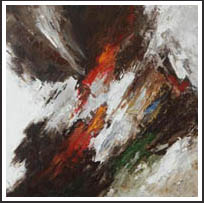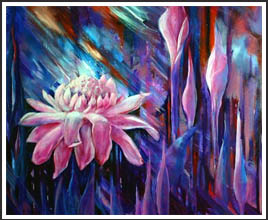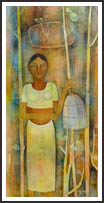What is the difference
between watercolor, oil, acrylic, and gouache paints?
The 3 major groups of paints are oil, acrylic, and watercolor. Watercolor and gouache tends to be the least expensive. Gouache is a fast-drying opaque watercolor, giving it the drying of a watercolor and the depth of an acrylic. Art created in oil tends to sell for the highest of the three although lately the distinction between oil and acrylic has lessened.
Acrylic is a water-based paint, more opaque and slower
drying than a watercolor. Many artists are using this
medium rather than oil because it is faster drying than
oil and does not require solvents for diluting or clean-up.
The finished surface of acrylics is also non-porous.
A disadvantage to acrylic is it will crack if subjected
to below freezing conditions so care in winter should
be considered. There is a recent trend of underpainting
oil paintings with acrylics. Acrylics do not have
the luminosity that oils create.
Oil is the "old master's" medium. It is the slowest drying of the three main mediums and it is considered not fully "cured" enough to varnish and seal for a longer period of time than acrylics. The luminosity and depth of color, the given longevity of oil, and the blending ability of oil are what make this medium my favorite. When I work with oils, there seems to be a magical quality that allows oils to bring out aspects and liveliness in my paintings.
 Abstract Art Abstract Art
In its purest form in Western art, an abstract art is one without a recognisable subject, one which doesn't relate to anything external or try to "look like" something. Instead the colour and form (and often the materials and support are the subject of the abstract painting. It's completely non-objective or non-representational.
Abstract art is a form of artistic expression, which does not represent reality as visible to us. Instead, though it takes its inspiration from the real world, it makes use of patterns for expression. These patterns establish independent relationships with the onlooker, with no reference to the original source of inspiration.
Acrylic
 Acrylic painting executed in the medium of synthetic acrylic resins. Acrylics dry rapidly, serve as a vehicle for any kind of pigment, and are capable of giving both the transparent brilliance of watercolour and the density of oil paint. They are considered to be less affected by heat and other destructive forces than is oil paint. Because of all these desirable characteristics, it has become popular amongst some artists Acrylic painting executed in the medium of synthetic acrylic resins. Acrylics dry rapidly, serve as a vehicle for any kind of pigment, and are capable of giving both the transparent brilliance of watercolour and the density of oil paint. They are considered to be less affected by heat and other destructive forces than is oil paint. Because of all these desirable characteristics, it has become popular amongst some artists
We can say it is a kind of paint which uses a synthetic medium instead of a natural one.
Etching
Etching is a painstaking means of artistic expression, which also requires a mastery over the technique. It involves the use of an acid on a metal plate to create a design. The term also indicates the designs created by employing the method of etching. With the help of a needle, the design is scratched through an acid resistant coating. The scratching exposes the metal beneath in specific areas. This plate is then immersed in an acid bath and the acid affects only the scratched parts creating the intended designs. The depth of the lines is determined by the duration of time for which the plate remains immersed in the acid. The process can be repeated or prolonged for those parts where the design needs to be emphasized. The parts which are being shielded from the acid, are coated with varnish.
Figurative
 Art inspired by and representative of the real, visible world. It takes visible objects as its base and then distorts or alters them to convey message. The human from is the most common base for these paintings. Art inspired by and representative of the real, visible world. It takes visible objects as its base and then distorts or alters them to convey message. The human from is the most common base for these paintings.
Figurative art describes art work particularly paintings - which are clearly derived from real object sources, and are therefore by definition representational. The term "figurative art" is often taken to mean art which represents the human figure, or even an animal figure, and, though this is often the case, it is not necessarily so.
Gallery
The general meaning would be a narrow passage attached to a large room with openings into it. But in our context, it is a place reserved for the display and sale of paintings and other work of art.
An art gallery or art museum is a space for the exhibition of art usually visual art, and usually primarily paintings. Sculpture, photographs, illustrations, and objects from the applied arts may also be shown. The term is used both for both public galleries, which are museums for the display of a permanent collection of art, and private galleries, which are commercial enterprises for the sale of art. However both types of gallery may host temporary exhibitions including art borrowed from elsewhere.
The term contemporary art gallery refers to a usually a privately-owned for-profit commercial gallery. These galleries are often found clustered together in urban centers such as the Chelsa district of New York, widely considered to be the center of the contemporary art world. Most large urban areas have several private art galleries, and most towns will be home to at least one. However, they may also be found in small communities,
Gouache
A type of painting made with the use of opaque watercolors. The term is also used for the medium of such a painting. The filler used in this case is most often opaque white, which gives a chalky look to the painting. The pigments are bound by gum.
Opaque watercolour. Also known as poster paint, designer's colour, and body colour, it differs from transparent watercolour in that the pigments are bound by liquid glue, which is used as a thinner. The addition of white pigment lightens the tone and lends opacity. Gouache paints dry to a matte finish and, if desired, without visible brush marks. They can be applied thinly or thickly. A wide range of colours are available, including fluorescent and metallic pigments. The suede finish and crisp lines characteristic of many Indian and Islamic miniature paintings is produced by this medium; it is used in Western screen and fan decoration and was used by modern artists such as Georges Rouault and Paul Klee.
Ground
Ground is the surface that has been especially prepared for painting. The support, such as canvas or paper, along with the base coats of desired material, on which a painting is made.
Medium
The pigment which is used to get the required colour in a painting, needs to be suspended in some liquid. This liquid is called the medium. In an oil painting, for example, the paints are dissolved in linseed oil, so the medium is oil. Medium also refers to the material used by an artist to give expression to his creativity. For instance, a sculptor uses stone as his medium of expression.
Landscape
 Representation of inland scenery, such as a countryside view or city skyline; also a format of painting that is wider than its height. Landscape paintings were produced in China in the early centuries AD, but are not thought to have appeared in Western art until the Middle Ages, when they were incorporated as background elements in illuminated manuscripts and paintings. The Italian painter Ambrogio Lorenzetti is credited with making the first painting devoted to landscape in around 1335. However, commissioned works continued to focus on portraiture, and religious and mythological scenes, until the 17th century when ‘classical landscape’ developed, and the works of Rubens and the Dutch School promoted the genre. The depiction of landscape as a display of property is exemplified by Gainsborough's Mr and Mrs Andrews (c. 1748), a portrait set against a wide landscape of their land. Impressionism was the last great phase of landscape objectively treated, though it was not the end of its development. Cézanne made landscape into a study of essential structure underlying all natural forms; Vincent van Gogh made it a vehicle for expressing personal emotion. Other significant landscape artists include J M W Turner, whose shimmering works anticipated Impressionism; and Thomas Cole, founder of the Hudson River School, the first American school of landscape painting Representation of inland scenery, such as a countryside view or city skyline; also a format of painting that is wider than its height. Landscape paintings were produced in China in the early centuries AD, but are not thought to have appeared in Western art until the Middle Ages, when they were incorporated as background elements in illuminated manuscripts and paintings. The Italian painter Ambrogio Lorenzetti is credited with making the first painting devoted to landscape in around 1335. However, commissioned works continued to focus on portraiture, and religious and mythological scenes, until the 17th century when ‘classical landscape’ developed, and the works of Rubens and the Dutch School promoted the genre. The depiction of landscape as a display of property is exemplified by Gainsborough's Mr and Mrs Andrews (c. 1748), a portrait set against a wide landscape of their land. Impressionism was the last great phase of landscape objectively treated, though it was not the end of its development. Cézanne made landscape into a study of essential structure underlying all natural forms; Vincent van Gogh made it a vehicle for expressing personal emotion. Other significant landscape artists include J M W Turner, whose shimmering works anticipated Impressionism; and Thomas Cole, founder of the Hudson River School, the first American school of landscape painting
This refers to the painting where the physical size has greater width than height. The name comes from the theme of landscape, which is typically painted in such proportions. Landscape, as a theme, is a painted or photographic representation of a view of natural surroundings
Lithograph
Printmaking technique invented in 1798 by Aloys Senefelder, based on the mutual repulsion of grease and water. A drawing is made with greasy crayon on an absorbent stone, which is then wetted. The wet stone repels ink (which is greasy) applied to the surface and the crayon absorbs it, so that the drawing can be printed. Lithographic printing is used in book production, posters, and prints, and this basic principle has developed into complex processes.
Many artists have made brilliant use of the process since the early 19th century, including Delacroix, Goya, Isabey, Bonington, Daumier, Gavarni, Whistler, Toulouse-Lautrec (who devised colour effects of the most striking and original kind), Bonnard, and Vuillard.
It can be said that Lithography is a method of printing lithograph is the print made by this technique. A drawing made on a zinc plate or a limestone block using a greasy material. The plate is then wet and a greasy ink is applied to it, which sticks only to the lines that have be drawn. A special press is now used to rub a moist paper all over the plate to make a print or a lithograph.
Mix Media
Mixed media painting combines different painting (and drawing) materials and methods, rather than using only one in a painting. This collection of articles will help you explore mixed media painting.
A relatively new (20th century) art form in which combined use of different types of physical materials is made together. An art creation which involves a combination of various media into one.
What is the difference between "signed and numbered", "artist's proofs", giclee, and canvas prints?
The term "print" is liberally used in the marketing of any artwork which is put onto paper or canvas. There are two main categories of this broad term; limited and unlimited prints.
Unlimited prints will have no maximum number of prints. Posters, note cards, other similar products, and open editions are usually presented in unlimited numbers.
Limited prints (signed and numbered) means that the printer is creating a piece which has a maximum number of pieces printed. Each print in a limited edition are hand signed and numbered by the artist. If it is an edition of 500, the first print will be 1 of 500 (1/500), the remainder sequentially numbered until the last is numbered 500/500. The publisher should not reissue this print once the edition is completed. Artist's Proofs are printed when the limited edition prints are printed. These prints are selected by the artist from the regular edition for highest quality. The number of artist's proofs selected is typically 10% of what the regular edition will be. To add to our example above, there would be an edition of 50 artist's proofs.
A giclee print is the process of printing the image from a digital scan. The advantage of this method is a more versatile and accurate color translation from the original image. With the advent of new technology, the best inks combined with the right paper have an image life up to twice as long as a regular printed limited edition. My favorite paper for printing giclees is d'arches watercolor paper for it's rich texture and velvety surface.
Canvas Editions are done two different ways. The first method is inks printed directly on the canvas. The best inks should be of UV quality. The second method consists of a paper print applied over the top of canvas to create the texture of canvas. These prints are usually sealed with an acrylic or varnish finish.
What is a remarque?
A remarque is a small original that is painted in the bottom margin of a limited edition print. Purchasing a print with a remarque give the piece a unique quality. The remarques are one of a kind originals and will not be duplicated exactly the same again. The value of a print is greatly enhanced by acquiring a remarque with a print. Remarques require a small added fee to the purchase price of a print.
What's the Difference Between Using Wax Resist and Masking Fluid?
Ordinary masking fluid you rub off once your painting is dry; wax gets left on the paper (you also get permanent masking fluid, which is designed to be left on the paper). Masking fluid is a total block – when you rub it off you're left with a solid area of pure white paper – whereas with wax it depends on how solidly or evenly you apply it. With wax the degree to which it repels the paint depends on how much was applied. Some paint may collect in little drops on the surface of the wax, creating a textured effect rather than pure white. |



